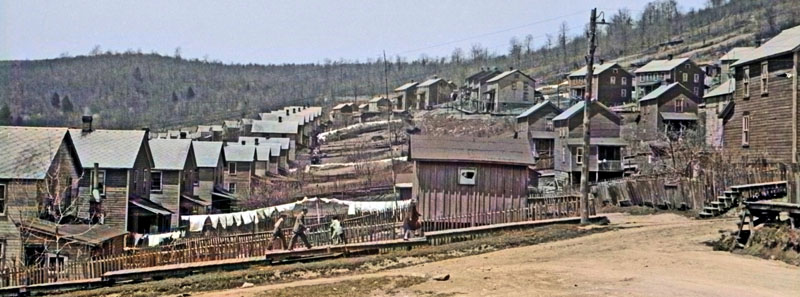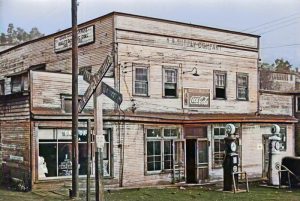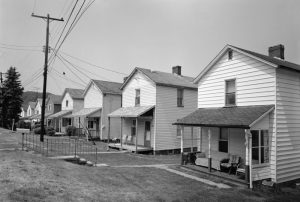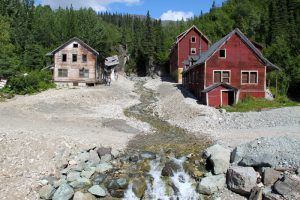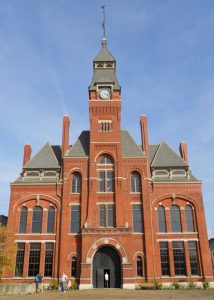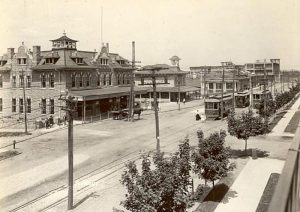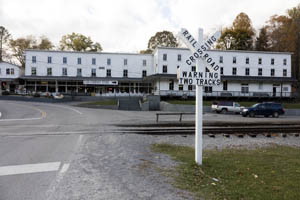Company Towns of America – Legends of America (original) (raw)
Kempton, West Virginia Company Town, By John Vachon, 1939.
As part of the labor market, company towns were economic institutions that were popular at the turn of the 20th century.
In many cases, these towns were developed in remote locations to service mining, railroad construction, logging, dam sites, factories, and war-industry camps. Far from other established towns, the companies generally owned all the buildings, businesses, and homes. The town’s citizens either worked in the industry, worked in one of the smaller businesses, or was a family member of someone who did.
In some situations, company towns had high ideals and were developed out of a paternalistic effort to create a utopian-type village. Stores, schools, churches, libraries, recreation facilities, parks, and even hospitals were constructed to encourage healthy communities and productive workers. Saloons and other bawdy places were prohibited.
Company Store in Osage, West Virginia by Marion Post Wolcott, 1938.
In other cases, the company’s motivations were entirely profit-motivated, controlling, and exploitative. In some towns, companies paid employees with a scrip that was only good at their company stores. A substitute for legal tender, scrip limited external competition, and employers took advantage by increasing housing costs and groceries. Sometimes companies prevented peddlers or deliveries from independent stores from entering the towns. This made workers dependent on the company, often causing workers to build up large debts, and enforced employee “loyalty,” as the workers were required to pay off any debt before leaving. While scrip was not exclusive to the coal industry, an estimated 75% of all scrip used was by coal companies in Kentucky, Virginia, and West Virginia. Payment in scrip became illegal in 1938 as part of the Fair Labor Standards Act.
Often prices charged in company stores were deemed excessive. The United States Census in 1910 found that many mines reported revenues from their mining operations were lower than their expenses and that they stayed in business by selling goods and services to their employees. The United States Coal Commission surveyed stores in mining districts in 1922. They found that stores in southern West Virginia mining districts of New River and Kanawha had prices that were approximately 9 and 5 percent higher than in the nearby city of Charleston. These stores carried necessities and amenities, such as washing machines, radios, and refrigerators, available for purchase on credit.
Company houses in Salina, Pennsylvania.
These monopoly franchises also controlled housing, security, and utilities, dispensed justice, and answered (or failed to answer) complaints. With the town’s entire economy “privatized,” all services were provided with company profits always in mind. There were no elected government officers — all authority and decisions were held by the company.
Because of numerous labor struggles associated with the coal industry, company towns are often associated with coal mining. It is also due to the isolated mining regions where mines were developed. In the early 1920s, the United States Coal Commission found that in West Virginia, Kentucky, Tennessee, Maryland, Virginia, Alabama, and the Rocky Mountains, 65 to 80 percent of miners lived in company towns.
Company houses were leased to workers so long as the company employed them. These “contracts” generally allowed for a quick termination, usually five days, rather than longer notices. Many leases prevented non-employees, except for family members, from living in or trespassing on company housing. In some cases, companies reserved the right to enter the property and the right to make and enforce regulations on the roads leading into the property. These rights were commonly enforced during strikes when miners were evicted from their homes.
Hospital and East Bunkhouses in the company town of Kennecott, Alaska, by the National Park Service.
Some of the earliest coal camps consisted of boarding houses for the mostly unmarried male miners. Duplexes and single-family houses were more common after the 1910s when companies actively recruited a more stable workforce of married men with families. Squeezed between mountains and stretched out along creeks, the camps often were divided along class, ethnic, and racial lines. African Americans and various immigrant groups were typically forced to live in separate sections of company towns. Mining town sections carried names such as “Pink Town” (native white), “Colored Hill” (African American), “Hunk Town” (Eastern European), and “Quality Hill” (company officials). Racial and ethnic violence occurred in several communities. To maximize productivity while maintaining peace, coal companies tried to balance numbers among native whites, blacks, and immigrants, with blacks attending different churches and schools. Even after the establishment of permanent housing, coal towns often lacked adequate sewerage and water facilities.
The characteristic of coal towns was the influence of the company. Companies built hospitals, hotels, recreation halls, schools, theaters, and stores for miners and their families. They paid for medical personnel and teachers. Some companies sponsored garden awards, gave chocolate and fruit to children at Christmas, and encouraged sports, bands, and events.
Company towns existed in many other industries. Lowell, Massachusetts, founded in 1822, was the first company town. Lowell, a textile mill town, has been viewed as paternalistic and symbolic of the exploitation and control of workers. Homestead, Pennsylvania, was a company town next to the Homestead Steel Mill. Pullman, Illinois, was a town for workers employed at the factory that produced Pullman railroad cars. This town failed politically due to a lack of elected officials and municipally owned services. When workers had no say in local affairs, they felt dictated to and lost their long-term affection for their town.
Riverside mills at Lowell, Massachusetts, about 1850.
Pullman, Illinois Clock Tower, and Administration Building courtesy Wikipedia.
By the 1920s, the need for company towns declined significantly due to the widespread use of the automobile and the establishment of highways. Despite income inequalities and a relatively low standard of living conditions amongst factory laborers and miners, the prosperity of the 1920s saw workers’ material well-being improve significantly. A strong post-war American economy meant installment buying was accessible to low-wage earners who could purchase previously unattainable goods like automobiles. This meant workers no longer needed to live near their workplaces and had access to more employment opportunities and healthcare, education, and other government-funded public resources. This newfound freedom saw a change in the mindset of workers, who began to look at welfare capitalism as demeaning rather than an incentive. During these years, hundreds of workers engaged in collective action through strikes, joining a union, or simply quitting and moving to a better location.
In 1923, the Coal Commission found that company towns were limited to newly settled and isolated areas. Towns declined as areas became more settled and connected to transportation networks.
With the economic downturn of the early 1930s, some businesses did away with employee welfare schemes to reduce costs. However, the Roosevelt Administration’s New Deal dealt the final blow to end company towns by raising minimum wages, encouraging industrial self-governance, and pushing for the owners of company towns to “consider the question of plans for eventual employee ownership of homes.”
Many former company towns were abandoned in the following years when mines shut down. Some became regular communities when they could attract more people and businesses, such as Anniston, Alabama. Others, like Homestead, Pennsylvania, are now a suburb of a larger city. However, many towns were devastated when they lost their primary employer, forcing people to find work elsewhere.
Other company towns included:
Hershey, Pennsylvania, was one company town that met its ideal as a Utopia-type town.
One town that was successful in becoming a working man’s utopia was Hersey, Pennsylvania. The town was founded by Milton Hershey in 1903 for the company’s workers to provide “a perfect American town in a bucolic natural setting, where healthy, right-living, and well-paid workers lived in safe, happy homes.” Homes had modern amenities such as electricity, indoor plumbing, and central heating. The town had a public trolley system; a free school to educate employees’ children; a free vocational school to train orphaned and underprivileged boys; and later, an amusement park, golf courses, community center, hotel, zoo, and a sports area. Believing that success in business and service to his fellow man went hand in hand, Hershey also built and subsidized his town’s public buildings, a department store, sports facilities, a hotel, and a medical clinic. He paid his workers well, who spent their money in the town he built and controlled.
In Segundo, Colorado, the Colorado Fuel & Iron Company housed its workers here, offering adequate housing and promoting upward mobility through its sponsorship of a YMCA Center, an elementary school, some small businesses, and a company store. However, air pollution was a constant health threat, and the houses lacked indoor plumbing. As demand for metallurgical coke declined, the mine laid-off workers and Segundo’s population declined. After a major fire in 1929, the company left town, and Segundo became a near ghost town.
One famous company town was McDonald, Ohio, created by the Carnegie Steel Company to house and serve the needs of its employees in the Youngstown area.
The old Company Store in Cass, West Virginia. The town is a state park today. Photo by Carol Highsmith.
Marktown, Indiana, was a planned steel manufacturing community established by Claton Marks in 1917. The Marktown Historic District was added to the National Register of Historic Places in 1975.
Cass, West Virginia, is a former company town that is now a state park. Cass was created in 1901 as a company town for those who worked for West Virginia Pulp and Paper Company, logging the nearby Cheat Mountain. The Cass Historic District was listed on the National Register of Historic Places in 1980.
There were more than 2,500 company towns at their peak, housing three percent of the U.S. population. Most of the people living in these towns were immigrants new to the country.
©Kathy Alexander/Legends of America, April 2023.
Also See:
Revitalizing Abandoned Coal Mining Towns: Exploring Opportunities for Repurposing and Sustainability
Industrial American and the Progressive Era Timeline, 1876-1929
Mining on the American Frontier
Pullman, Illinois – A Model Company Town
Sources:
Economic History Association
Public Broadcasting System
Wikipedia
